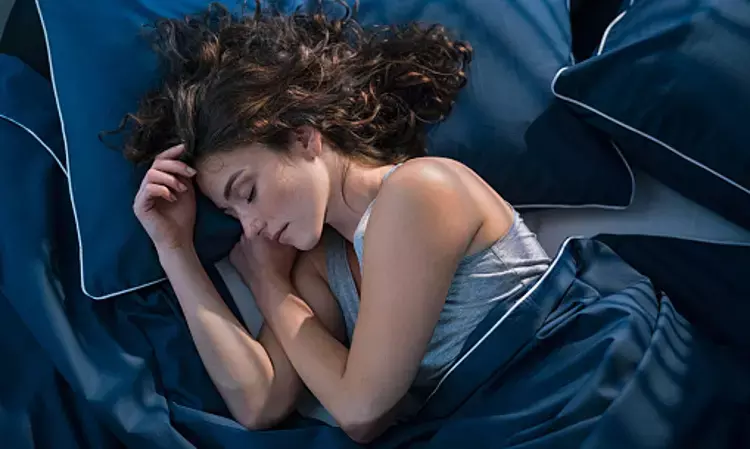- Home
- Medical news & Guidelines
- Anesthesiology
- Cardiology and CTVS
- Critical Care
- Dentistry
- Dermatology
- Diabetes and Endocrinology
- ENT
- Gastroenterology
- Medicine
- Nephrology
- Neurology
- Obstretics-Gynaecology
- Oncology
- Ophthalmology
- Orthopaedics
- Pediatrics-Neonatology
- Psychiatry
- Pulmonology
- Radiology
- Surgery
- Urology
- Laboratory Medicine
- Diet
- Nursing
- Paramedical
- Physiotherapy
- Health news
- Fact Check
- Bone Health Fact Check
- Brain Health Fact Check
- Cancer Related Fact Check
- Child Care Fact Check
- Dental and oral health fact check
- Diabetes and metabolic health fact check
- Diet and Nutrition Fact Check
- Eye and ENT Care Fact Check
- Fitness fact check
- Gut health fact check
- Heart health fact check
- Kidney health fact check
- Medical education fact check
- Men's health fact check
- Respiratory fact check
- Skin and hair care fact check
- Vaccine and Immunization fact check
- Women's health fact check
- AYUSH
- State News
- Andaman and Nicobar Islands
- Andhra Pradesh
- Arunachal Pradesh
- Assam
- Bihar
- Chandigarh
- Chattisgarh
- Dadra and Nagar Haveli
- Daman and Diu
- Delhi
- Goa
- Gujarat
- Haryana
- Himachal Pradesh
- Jammu & Kashmir
- Jharkhand
- Karnataka
- Kerala
- Ladakh
- Lakshadweep
- Madhya Pradesh
- Maharashtra
- Manipur
- Meghalaya
- Mizoram
- Nagaland
- Odisha
- Puducherry
- Punjab
- Rajasthan
- Sikkim
- Tamil Nadu
- Telangana
- Tripura
- Uttar Pradesh
- Uttrakhand
- West Bengal
- Medical Education
- Industry
Lower-sodium oxybate shows reduction in idiopathic hypersomnia symptoms: Lancet

Idiopathic hypersomnia, a central hypersomnolence condition characterized primarily by extreme daytime drowsiness, protracted nighttime sleep, and prominent sleep inertia.
Lower-sodium oxybate medication resulted in a clinically substantial reduction in idiopathic hypersomnia symptoms, with an overall safety profile similar to that described for narcolepsy, according to a recent research.
This study was conducted by Yves Dauvilliers and team with the objective to assess the safety and effectiveness of lower-sodium oxybate in idiopathic hypersomnia. The findings of this study were published in Lancet Neurology.
This was a phase 3 placebo-controlled, double-blind, randomized withdrawal research involving 50 specialized sleep institutes from six EU nations and the United States. Participants (aged 18–75 years) with idiopathic hypersomnia (meeting criteria from the International Classification of Sleep Disorders, 2nd or 3rd editions) began treatment with lower-sodium oxybate (oral solution once or twice nightly) in an open-label titration and optimization period (10–14 weeks), followed by a 2-week open-label, stable-dose period. Following these open-label periods, participants were randomly assigned (1:1) to either placebo or lower-sodium oxybate (individually optimized dose; range 25–90 g/night) during a 2-week, double-blind, randomized withdrawal period using an interactive web recognition system, stratified by participants' baseline medication use.
The primary efficacy endpoint was the change in Epworth Sleepiness Scale (ESS) score from the end of the stable-dose period to the end of the double-blind, randomized withdrawal period in the modified intention-to-treat population (defined as all participants who were randomly assigned, took at least one dose of study medication during the withdrawal period, and had at least one set of post-randomization assessments for the primary or key secondary endpoints). Adverse occurrences in the safety population were evaluated (defined as all participants who took at least one dose of study medication).
The results were as follow:
1. The safety population consisted of 154 individuals who were enrolled between November 27, 2018, and March 6, 2020. ESS scores dropped from a mean of 157 (SD 38) at the start of the stable-dose period to 61 (40) at the conclusion.
2. Following the open-label periods, 115 patients were randomly randomized to either placebo (n=59) or lower-sodium oxybate (n=56), making up the modified intention-to-treat group.
3. ESS ratings rose (worsened) in those randomly allocated to placebo but were consistent in those randomized to lower-sodium oxybate over the double-blind, randomized withdrawal phase. Nausea (34 [22%] of 154), headache (27 [18V] of 154), dizziness (19 [12V] of 154), anxiety (17 [11V] 154), and vomiting were among the treatment-emergent adverse effects (17 [11 percent ] 154). During the course of the trial, no fatalities were documented.
In conclusion, the results demonstrate that lower-sodium oxybate is beneficial in individuals with idiopathic hypersomnia, with an overall acceptable safety profile. The withdrawal design may include inherent constraints that must be considered. The US Food and Drug Administration authorized lower-sodium oxybate for the treatment of idiopathic hypersomnia in adults in August 2021.
Reference: Safety and efficacy of lower-sodium oxybate in adults with idiopathic hypersomnia: a phase 3, placebo-controlled, double-blind, randomised withdrawal study. Dauvilliers, Yves et al. DOI:https://doi.org/10.1016/S1474-4422(21)00368-9
Medical Dialogues consists of a team of passionate medical/scientific writers, led by doctors and healthcare researchers. Our team efforts to bring you updated and timely news about the important happenings of the medical and healthcare sector. Our editorial team can be reached at editorial@medicaldialogues.in.
Dr Kamal Kant Kohli-MBBS, DTCD- a chest specialist with more than 30 years of practice and a flair for writing clinical articles, Dr Kamal Kant Kohli joined Medical Dialogues as a Chief Editor of Medical News. Besides writing articles, as an editor, he proofreads and verifies all the medical content published on Medical Dialogues including those coming from journals, studies,medical conferences,guidelines etc. Email: drkohli@medicaldialogues.in. Contact no. 011-43720751


